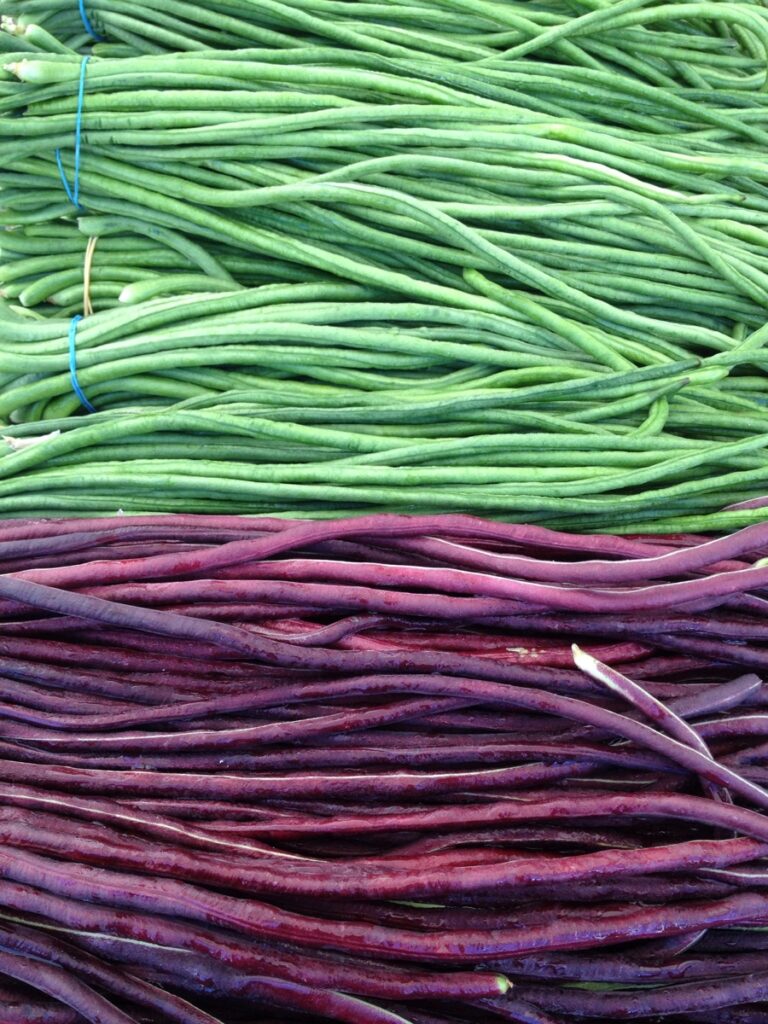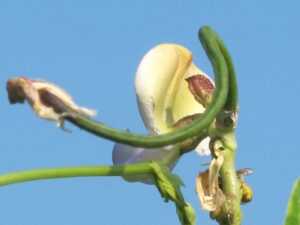Over the past weeks, Chubeza’s lubia has been ripening in abundant quantities, making a formal announcement that summer is at its peak. If you’ve been wondering why the latest green beans you’ve been receiving are so lengthy and coarse, well, it’s because they’re not green beans but rather… Thai lubia (yard-long beans) which arrive “gift-wrapped” in your boxes. They are indeed a present, albeit rather strange and unique. But don’t expect them to be green beans, because they simply are not…
Thai bean/lubia (V. unguiculata ssp. Sesquipedalis) is a relative of the common bean, chickpea, soy, fava bean and other members of the Faboideae family we so love to nibble on. Like them, the Thai lubia wears two outfits: the green cloak, eaten in long green pods, and the dry attire where only the dry seeds are consumed.
In English, Thai lubia is known as the yard-long bean, bora bean, long-podded cowpea, asparagus bean, pea bean, snake bean, or Chinese long bean. All names relate to this bean’s various characteristics: it originates in Southeast Asia, hence the “Chinese” or “Thai” title, and can reach the hearty length of half a meter (though it’s generally harvested young, at approximately 30 cm. long and 1 cm thick). Lubia is similar to asparagus in diameter and length, and because of its flexibility may resemble a green snake (to those of you with overactive imaginations, at least). Its taste ranges between that of green beans and fresh green lubia, whilst the texture is more akin to lubia, less crunchy than the green bean and more flexible.
In its growth, lubia requires more heat than the green bean, and manages quite well throughout the sweltering months of summer (which certainly cannot be said of green beans who faint under the scorching sun). It is seeded in late spring, and we trellis it like peas, on poles with a net spread between the stalks on which the young plants climb adeptly and efficiently. Blooms begin within three months with a couple of beautiful flowers on each pole, resembling two butterflies. A pair of beans ripens from those two, adjacent to each other at the ends, like a couple of twin green worms (how about that! I just managed to think up a new name!).
Contrary to green beans or peas, the lubia grows slowly and yields pods only after more than three months (compared to two or less). But this has its advantages – we can harvest the lubia on and on, till the temperatures drop in wintertime. These beans must be harvested with care, as the bloom pole continues to develop flowers throughout the season.
The Thai yard-long bean can be harvested, like at Chubeza, at a young stage at less than 30 cm long and 1 cm thick, and be used in the same way as one would prepare fresh lubia or green bean. You can also allow the pods to mature on the plant and use the black, red or white (depending on the variety) seeds as you would use dry lubia pods or any dry bean.
At Chubeza, we grow the green variety which bears black seeds, but in Asia there is a magnificent array of colorful, bountiful types. On the outside, the pods come in green and various violets while the seeds can be black, white, brown or red.

Thai yard-long beans can be used in recipes calling for green beans or fresh lubia, including soups, quiches and fresh salads. In China, it is lightly stir-fried, and is actually the original bean to have been used in stir-fried dishes. It tastes wonderful with fish and even pickled. The yard-long bean is rich in Vitamin A and Vitamin C as well.
The lubia recipes featured on our website range from easy to complicated, all delicious, of course. But if you don’t feel like firing up a cooking flame in this scorching heat, just help yourself to a long snake bean and nibble away!
Enjoy a week full of summer abundance and a true feeling of vacation,
Alon, Bat-Ami, Dror, Orin, Yochai and the entire Chubeza team
___________________________________
WHAT’S IN THIS WEEK’S BOXES?
Monday: Potatoes, corn, onions/okra, eggplant, cucumbers, tomatoes, lubia Thai yard-long beans, slice of pumpkin, parsley/coriander, cherry tomatoes, red bell peppers
Large box, in addition: Butternut squash, New Zealand spinach, garlic/scallions.
ALL FRUIT BOXES: Pears, apples, plums. Small boxes, in addition: Bananas. Large boxes, in addition: Nectarines
Wednesday: Potatoes, onions/okra, eggplant, cucumbers, tomatoes, lubia Thai yard-long beans, slice of pumpkin, parsley/coriander, cherry tomatoes, red bell peppers. Small boxes: Butternut squash/corn
Large box, in addition: New Zealand spinach, scallions, Butternut squash and corn
ALL FRUIT BOXES: Pears, apples, plums, bananas. Large boxes, in addition: mango


